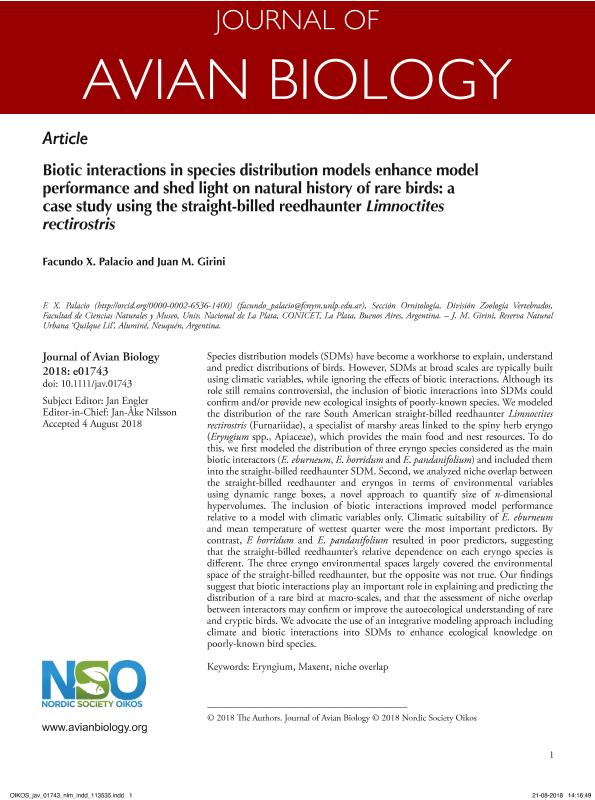Mostrar el registro sencillo del ítem
dc.contributor.author
Palacio, Facundo Xavier

dc.contributor.author
Girini, Juan Manuel

dc.date.available
2020-03-19T20:07:59Z
dc.date.issued
2018-11
dc.identifier.citation
Palacio, Facundo Xavier; Girini, Juan Manuel; Biotic interactions in species distribution models enhance model performance and shed light on natural history of rare birds: a case study using the straight-billed reedhaunter Limnoctites rectirostris; Wiley Blackwell Publishing, Inc; Journal Of Avian Biology; 49; 11; 11-2018; 1-12
dc.identifier.issn
0908-8857
dc.identifier.uri
http://hdl.handle.net/11336/100359
dc.description.abstract
Species distribution models (SDMs) have become a workhorse to explain, understand and predict distributions of birds. However, SDMs at broad scales are typically built using climatic variables, while ignoring the effects of biotic interactions. Although its role still remains controversial, the inclusion of biotic interactions into SDMs could confirm and/or provide new ecological insights of poorly-known species. We modeled the distribution of the rare South American straight-billed reedhaunter Limnoctites rectirostris (Furnariidae), a specialist of marshy areas linked to the spiny herb eryngo (Eryngium spp., Apiaceae), which provides the main food and nest resources. To do this, we first modeled the distribution of three eryngo species considered as the main biotic interactors (E. eburneum, E. horridum and E. pandanifolium) and included them into the straight-billed reedhaunter SDM. Second, we analyzed niche overlap between the straight-billed reedhaunter and eryngos in terms of environmental variables using dynamic range boxes, a novel approach to quantify size of n-dimensional hypervolumes. The inclusion of biotic interactions improved model performance relative to a model with climatic variables only. Climatic suitability of E. eburneum and mean temperature of wettest quarter were the most important predictors. By contrast, E horridum and E. pandanifolium resulted in poor predictors, suggesting that the straight-billed reedhaunter's relative dependence on each eryngo species is different. The three eryngo environmental spaces largely covered the environmental space of the straight-billed reedhaunter, but the opposite was not true. Our findings suggest that biotic interactions play an important role in explaining and predicting the distribution of a rare bird at macro-scales, and that the assessment of niche overlap between interactors may confirm or improve the autoecological understanding of rare and cryptic birds. We advocate the use of an integrative modeling approach including climate and biotic interactions into SDMs to enhance ecological knowledge on poorly-known bird species.
dc.format
application/pdf
dc.language.iso
eng
dc.publisher
Wiley Blackwell Publishing, Inc

dc.rights
info:eu-repo/semantics/openAccess
dc.rights.uri
https://creativecommons.org/licenses/by-nc-sa/2.5/ar/
dc.subject
ERYNGIUM
dc.subject
MAXENT
dc.subject
NICHE OVERLAP
dc.subject.classification
Ecología

dc.subject.classification
Ciencias Biológicas

dc.subject.classification
CIENCIAS NATURALES Y EXACTAS

dc.title
Biotic interactions in species distribution models enhance model performance and shed light on natural history of rare birds: a case study using the straight-billed reedhaunter Limnoctites rectirostris
dc.type
info:eu-repo/semantics/article
dc.type
info:ar-repo/semantics/artículo
dc.type
info:eu-repo/semantics/publishedVersion
dc.date.updated
2020-03-05T14:58:26Z
dc.journal.volume
49
dc.journal.number
11
dc.journal.pagination
1-12
dc.journal.pais
Reino Unido

dc.journal.ciudad
Londres
dc.description.fil
Fil: Palacio, Facundo Xavier. Consejo Nacional de Investigaciones Científicas y Técnicas. Centro Científico Tecnológico Conicet - La Plata; Argentina. Universidad Nacional de La Plata. Facultad de Ciencias Naturales y Museo. División Zoología de Vertebrados. Sección Ornitología; Argentina
dc.description.fil
Fil: Girini, Juan Manuel. Consejo Nacional de Investigaciones Científicas y Técnicas. Centro Científico Tecnológico Conicet - La Plata; Argentina. Universidad Nacional de La Plata. Facultad de Ciencias Naturales y Museo. División Zoología de Vertebrados. Sección Ornitología; Argentina
dc.journal.title
Journal Of Avian Biology

dc.relation.alternativeid
info:eu-repo/semantics/altIdentifier/doi/https://doi.org/10.1111/jav.01743
dc.relation.alternativeid
info:eu-repo/semantics/altIdentifier/url/https://onlinelibrary.wiley.com/doi/abs/10.1111/jav.01743
Archivos asociados
